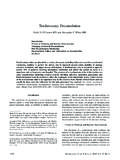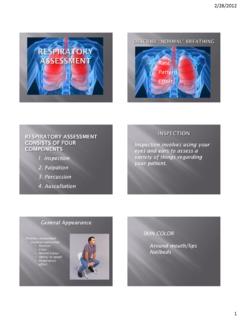Transcription of Viruses - WHO
1 World Health Organization (WHO). Water Recreation and Disease. Plausibility of Associated Infections: Acute Effects, Sequelae and Mortality by Kathy Pond. Published by IWA Publishing, London, UK. ISBN: 1843390663 6 Viruses This chapter summarises the evidence for viral illnesses acquired through ingestion or inhalation of water or contact with water during water-based recreation. The organisms that will be described are: adenovirus; coxsackievirus; echovirus; hepatitis A virus; and hepatitis E virus. The following information for each organism is presented: general description, health aspects, evidence for association with recreational waters and a conclusion summarising the weight of evidence.
2 192 Water Recreation and Disease HUMAN ADENOVIRUS Credibility of association with recreational water: Strongly associated I Organism Pathogen Human adenovirus Taxonomy Adenoviruses belong to the family Adenoviridae. There are four genera: Mastadenovirus, Aviadenovirus, Atadenovirus and Siadenovirus. At present 51 antigenic types of human adenoviruses have been described. Human adenoviruses have been classified into six groups (A F) on the basis of their physical, chemical and biological properties (WHO 2004). Reservoir Humans. Adenoviruses are ubiquitous in the environment where contamination by human faeces or sewage has occurred.
3 Distribution Adenoviruses have worldwide distribution. Characteristics An important feature of the adenovirus is that it has a DNA rather than an RNA genome. Portions of this viral DNA persist in host cells after viral replication has stopped as either a circular extra chromosome or by integration into the host DNA (Hogg 2000). This persistence may be important in the pathogenesis of the known sequelae of adenoviral infection that include Swyer-James syndrome, permanent airways obstruction, bronchiectasis, bronchiolitis obliterans, and steroid-resistant asthma (Becroft 1971; Tan et al. 2003).
4 They are unusually resistant to chemical or physical agents and adverse pH conditions, allowing for prolonged survival outside of the body. Adenovirus has been shown to be resistant to both tertiary treatment and UV radiation of urban wastewater (Thompson et al. 2003; Thurston-Enriquez et al. 2003). Viruses 193II Health aspects Primary disease symptoms and sequelae Adenoviruses are frequent causes of fevers, upper respiratory tract symptoms and conjunctivitis and produce infections that are usually mild and self limiting.
5 Adenoviral lower respiratory tract infections are infrequent, sporadic and most commonly associated with adenovirus types 3, 5 and 7 (Mandell 2000; Murtagh et al. 1993). Epidemic keratoconjunctivitis is associated with adenovirus serotypes 8, 19, and 37. Acute respiratory disease is most often associated with adenovirus types 4 and 7. Enteric adenoviruses 40 and 41 cause gastroenteritis, usually in children (Wilhelmi et al. 2003). Of the human adenoviruses belonging to the B subgenera, it is known that adenovirus types 3, 7, and 11 cause conjunctivitis (Kitamura 2001).
6 Adenovirus type 3 and 7, which belong to the B1 group, cause inflammation of the upper respiratory tract and pneumonia in addition to conjunctivitis (Murtagh and Kajon 1997), while adenovirus type 11, which belongs to Group B2, causes diseases such as cystitis and nephritis (Kitamura 2001). It has been suggested that there is a possible connection between adenovirus type 36 and obesity (Powledge et al. 2004). For some adenovirus serotypes, the clinical spectrum of disease associated with infection varies depending on the site of infection; for example, infection with adenovirus 7 acquired by inhalation is associated with severe lower respiratory tract disease, whereas oral transmission of the virus typically causes no or mild disease.
7 Many of the adenovirus serotypes can multiply in the small intestine, but only types 40 and 41 have been strongly associated with gastroenteritis (Grimwood et al. 1995). Adenovirus is considered to be second only to rotavirus in terms of its significance as a cause of childhood gastroenteritis (Crabtree et al. 1997). Studies covering the analysis of about 5000 faecal specimens during the period 1981 1996 indicate that adenoviruses contributed 3% to 9% of the gastroenteritis cases admitted to Australian hospitals. The majority of the cases were associated with young children and involved serotype 41 (40% to 80%) and to a lesser extent, serotype 40 (less than 20%).
8 Seasonal patterns of the virus genotypes were evident, with type 41 being prevalent in late autumn and type 40 remaining prevalent year-round (Grimwood et al. 1995; Palambo and Bishop 1996). Infection with adenovirus is usually acquired during childhood. Acute lower respiratory tract infections in children is a major worldwide health problem (Murray and Lopez 1996). In Argentina, viral infections have been shown to contribute to between 20% and 30% of all cases of acute lower 194 Water Recreation and Disease respiratory tract infections in children and in a community setting, approximately 14% of cases have been shown to be attributable to adenovirus (Avila et al.)
9 1989; Videla et al. 1998). This is higher than that reported in other countries. In Sweden for example, adenoviruses are reported to be responsible for 5% of acute lower respiratory infections in children under 4 years of age who require hospitalisation (Sharp and Wadell 1995). Although most adenovirus infections are mild, adenovirus is included in this review because rarely, these infections may be fatal and there are a number of sequelae associated with the viral infection. Acute necrotizing bronchitis and bronchiolitis may develop in children and in debilitated and immunocompromised patients (Edwards et al.
10 1985; Ruuskanen et al. 1985; Zahradnik et al. 1980). These infections may result in complications including recurrent wheezing, bronchiectasis and obliterative bronchiolitis (Simila et al. 1981; Sly et al. 1984; Hardy et al. 1988; Macek et al. 1994; Arce et al. 2000). Furthermore, adenoviral infections in lung transplant recipients may produce a rapidly progressive course leading to premature death (Ohori et al. 1995; Simsir et al. 1998). Unlike other viral pneumonitides ( herpes simplex virus, cytomegalovirus), no specific treatment for adenovirus pneumonitis exists. Viquesnel et al.

















